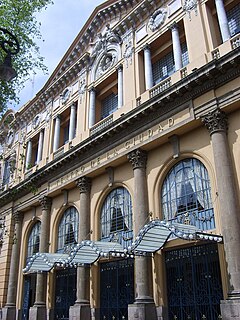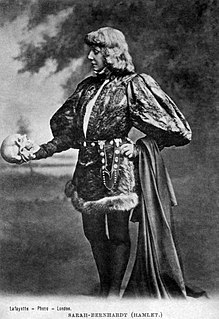
The Teatro Colón is the main opera house in Buenos Aires, Argentina. It is considered one of the ten best opera houses in the world by National Geographic, and is acoustically considered to be amongst the five best concert venues in the world.

Teatro El Círculo is a theater in Rosario, Argentina.

Teatro Real or simply El Real, as it is known colloquially, is a major opera house located in Madrid. Founded in 1818 and inaugurated on 19 November 1850, it closed in 1925 and reopened in 1966. Beginning in 1988 it underwent major refurbishing and renovation works and finally reopened in 1997 with a capacity of 1,746 seats. Today the Teatro Real opera is one of the great theaters of Europe hosting large productions involving leading international figures in opera singing, musical direction, stage direction and dance. The theater offers visitors guided tours in several languages, including the auditorium, stage, workshops and rehearsal rooms.
National Theatre or National Theater may refer to:

The Gran Teatro de La Habana is the former Centro Gallego. Designed by the Belgian architect Paul Belau and the U.S. firm of Purdy and Henderson, Engineers, was paid for by the Galician immigrants of Havana to serve as a their community- social center. Located in the Paseo del Prado, the theatre has been home to the Cuban National Ballet and to the International Ballet Festival of Havana. Its facilities include theatres, a concert hall, conference rooms, a video screening room, as well as an art gallery, a choral center, with several rehearsal halls for dance companies.
The National Symphony Orchestra is the state symphony orchestra of Peru; it is located in Lima. It is one of the components of the Peruvian Instituto Nacional de Cultura. As of 2007, the orchestra had ninety members. Besides the traditional classical repertory, the orchestra also performs Latin American and Peruvian works, including numerous world premieres.

The Teatro Nacional de Cuba is a theatre building and associated theatre company in Havana, Cuba, on Plaza de la Revolución.
Francisco Kraus Trujillo was a Spanish baritone.

The Teatro Argentino de La Plata is the second most important lyric opera house in Argentina, after the Teatro Colón in Buenos Aires. The theatre is located in a central block of the city of La Plata, the capital of Buenos Aires Province. The venue occupies the block bounded by the 9 and 10 streets and 51 & 53 avenues; it belongs to the Monumental Axis of public buildings in La Plata.

David Giménez Carreras is a Spanish conductor. He is the Music Director of the Orquestra Simfònica del Vallès. and a principal guest conductor of the George Enescu Philharmonic Orchestra. Giménez Carreras is the nephew of tenor José Carreras and has conducted many of his concerts, including the 1998 outdoor concert in Barcelona attended by 50,000 people to mark the 10th anniversary of the José Carreras International Leukemia Foundation.

The Teatro Nacional Cervantes in Buenos Aires is the national stage and comedy theatre of Argentina.

The Teatro de la Maestranza is an opera house located in Seville, Spain.
The Teatro Municipal de Lima is a theatre and concert hall in Lima, Peru. It is home to the National Symphony Orchestra of Peru. The building was inaugurated in 1920 under the name of "Teatro Forero". It was later bought by the "Municipalidad Metropolitana de Lima" in 1929 and renamed "Teatro Municipal". It was partially destroyed by a voracious fire in 1998. Since the fire, the building was sporadically open for special performances; however, it remained unrestored for 12 years.

In Venezuela, since the opening of the Teatro Caracas and, earlier, the Teatro Maderero, there whas been a great lyrical tradition ranging from serious opera to operetta, zarzuela, and Spanish musical reviews.

The Teatro de la Ciudad was built as the "Teatro Esperanza Iris" in 1918 and is now one of Mexico City’s public venues for cultural events. The theater is located in the historic center of Mexico City on Donceles Street 36.
The Great National Theatre of Mexico was a huge opera house in Mexico City.

The Lope de Vega Theatre is a small Baroque Revival theatre that was built for the Ibero-American Exposition of 1929 in Seville, Spain, in the same building as the Exhibition Casino. It stands in the Maria Luisa Park just north of the Pavilion of Peru. The theater is named after the famous 16th-century Spanish playwright Lope de Vega. After the exposition the theatre had a mixed history. It suffered damage from fire and flood. At times it was closed and at times was partially restored and reopened. The building has been used as a hospital and as a trade show venue. Following its most recent renovation the theatre has become one of Seville's most important centres for cultural events.

Margot is an opera in three acts composed by Joaquín Turina to a Spanish-language libretto by Gregorio Martínez Sierra. It premiered at the Teatro de la Zarzuela in Madrid on 10 October 1914. Set in Paris and Seville, the opera's story involves a love triangle between José Manuel, a young Spaniard; Margot, a Parisian courtesan with whom he has an affair; and Amparo, José Manuel's sweetheart in Andalucía.

Roger de Flor is an opera in 3 acts by Ruperto Chapí for libretto by Mariano Capdepón. It is the third of the three operas composed by Chapí during his studies in Paris and Italy. It was staged for the first time at the Teatro Real (Madrid) on January 23, 1878. The first modern performance was on March 10, 2012 in Palau de la Música de València.



















